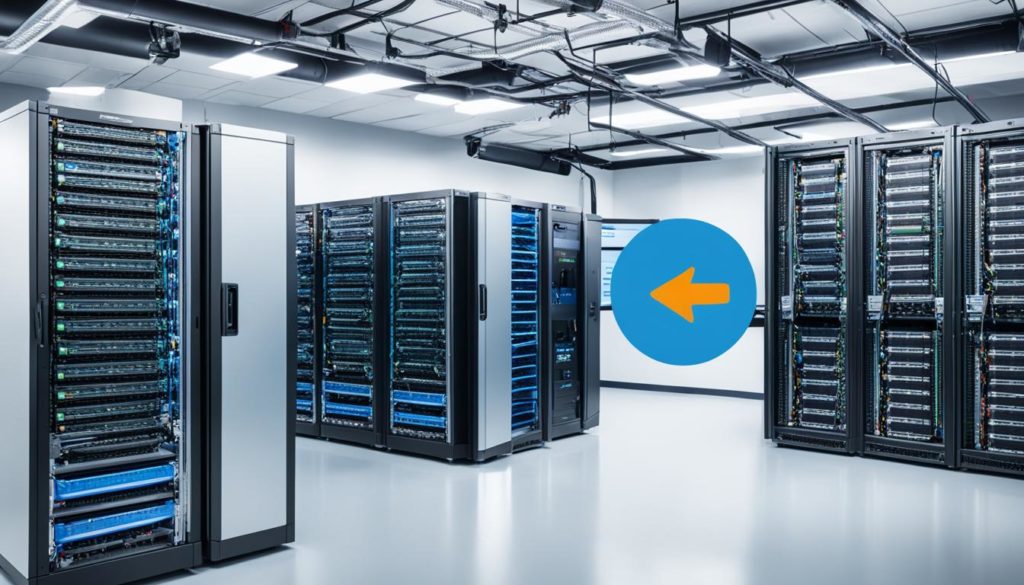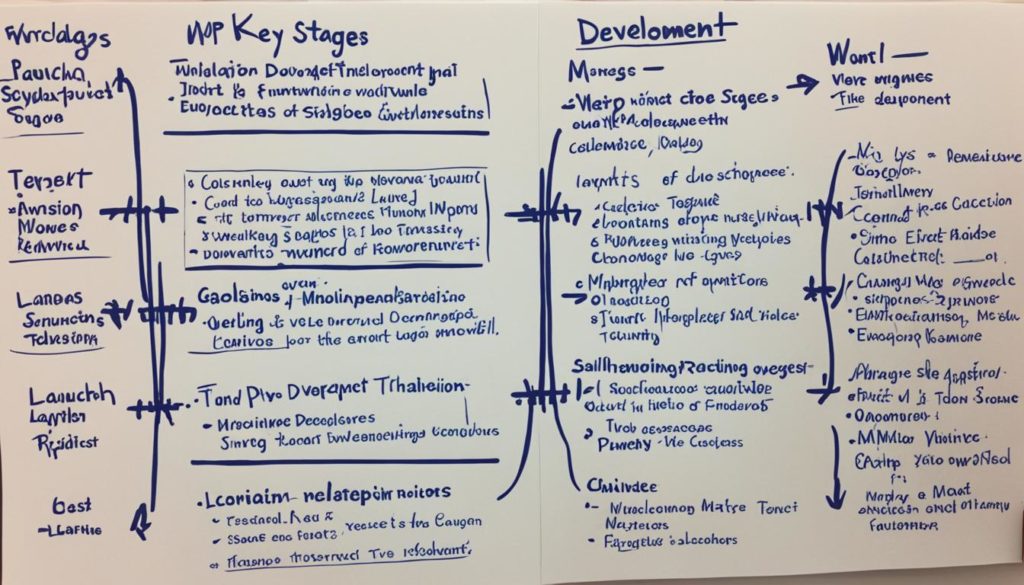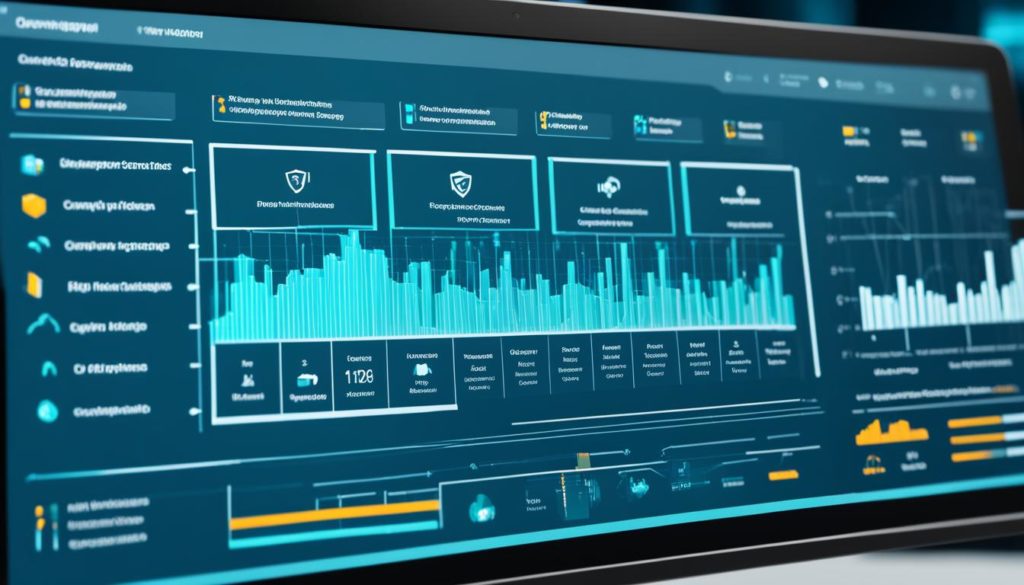
Flexera’s 2023 State of the Cloud Report shows managing cloud spend is a big challenge. Yet, 80% of businesses struggle with resources or expertise for cloud migration. This issue makes choosing between on-premises and cloud setups a key decision.
The on-premises vs cloud debate is crucial in today’s technology infrastructure and business decision-making. On-premises means keeping data and apps on local equipment, offering more security control. Cloud computing uses external servers, making it easy to scale and cut initial costs but hard to manage vendors and data rights.
Our article explains the key differences, helping businesses choose what’s best for them. Though on-premises has been popular, the cloud’s advantages and issues are now in focus. Understanding both options’ benefits, security, and costs is essential.
Key Takeaways
- On-premises solutions offer local control and robust security features, ideal for businesses requiring stringent compliance.
- Cloud computing gives scalability and flexibility with lower upfront costs, fitting for dynamic business needs.
- Effective cloud migration needs a wide range of skills like in cloud architecture, security, and DevOps.
- The main challenges for businesses include managing cloud costs and keeping track of usage.
- The COVID-19 pandemic pushed more companies toward the cloud, yet expertise scarcity and management difficulties remain.
Understanding On-premises Solutions
Businesses need to pick the right infrastructure model. On-premises solutions involve software and hardware at a company’s site. They offer advantages and challenges.
Definition and Core Concepts
A company must buy software licenses for on-premises use. This requires setting up servers and having IT staff. Businesses then control their applications and data closely.
Benefits of On-premises Hosting
On-premises hosting boosts data security. It’s best for companies in regulated fields. Initially expensive, it might save money over cloud services. Here are the benefits:
- Complete Control: Companies handle all data aspects.
- Enhanced Security: Tight control leads to better data safety.
- Long-term Savings: Over time, it could cost less than cloud usage.
Drawbacks and Challenges
But on-premises hosting also has downsides. The start-up cost for hardware and software is high. Maintaining everything requires lots of effort and money. Here are common issues:
- High Upfront Costs: Starts expensive with hardware and software costs.
- Maintenance Demands: Needs constant updates and management.
- Limited Flexibility: Adapting to changes is harder than with cloud options.
On-premises solutions bring strong data control and security. Yet, they’re initially costly and hard to maintain. Knowing these points helps in making the right choice for your business.
Exploring Cloud Computing
Cloud computing has changed how businesses handle their IT needs. It uses cloud services for flexibility and easy scaling, helping companies meet changing demands without big upfront costs. We’ll look closely at cloud computing and its effects on today’s businesses.
Key Features of Cloud Services
Cloud services stand out because they use virtual technology to run apps away from the office. This means no need for local hardware and ensures data is backed up, making things safer and more reliable. They also offer modern features like support for containers and microservices.
Advantages of Cloud Infrastructure
Cloud infrastructure brings many perks, especially in scalability and how costs are managed. It uses an OpEx model, letting businesses pay just for what they use. This way, companies can easily grow or shrink their resources, leading to great agility and savings.
Additionally, cloud setups deliver top performance and are always on, using APIs for easy app connections. They also offer better resilience since data is spread out, letting sites switch quickly if problems arise.
Potential Downsides
However, cloud computing isn’t perfect and has its drawbacks. A big issue is needing a steady internet connection, as outages can block access to key services. Even with strong security, companies might lose some control over their tech setups.
Ongoing subscription costs can add up, possibly outdoing traditional in-house system costs. Plus, the cloud may limit how much you can customize, which could be tricky for businesses with very specific needs.
| Aspect | Cloud Services | On-Premises |
|---|---|---|
| Cost Structure | OpEx, pay-per-use | CapEx, one-time purchase |
| Scalability | High | Limited |
| Control | Less control over hardware | Full control |
| Maintenance | Managed by provider | Managed in-house |
It’s important to weigh performance, scalability, cost, and control when choosing between cloud and in-house solutions. Knowing these factors helps companies make smart choices for their goals. For more details, see Hewlett Packard Enterprise’s insights on managing cloud versus in-house infrastructure.
On-premises vs Cloud: Key Differences
When looking at cloud vs on-premises, it’s important to know their key differences. These include cost, security, and how well they can grow with your needs. This comparison will help us make a wise choice.
Cost Comparison
Cost is a big factor when comparing cloud and on-premises. Buying servers and setting up a space costs a lot upfront for on-premises. There are also ongoing costs for keeping everything running. Cloud computing, however, has a pay-as-you-go approach. This can save money and make starting up quicker.
Security Implications
Security is super important when choosing between cloud and on-premises. With on-premises, you get more control because your data stays with you. This is good for companies with very private information. But, cloud services also work hard to protect your data. It’s up to the business to decide which option meets their security needs better.
Scalability and Flexibility
Being able to grow easily is another big difference. Cloud services let you adjust your resources with ease, which is great for changing needs. On-premises might require new hardware to grow, which can be costly and slow. For businesses with lots of data or that need fast processing, on-premises can be faster since it doesn’t depend on the internet.
For more information on cloud and on-premises options, check out on-premise vs cloud. You can also find more insights at cloud vs on-premise. These resources are great for understanding the different models and picking the best one for your needs.
Hybrid Cloud Solutions: A Middle Ground
Hybrid cloud solutions merge on-premises and cloud platforms. They use public clouds, private clouds, and on-site infrastructure. This mix gives businesses the flexibility to place applications where they fit best while keeping sensitive data under control.
This setup finds the right balance between public cloud’s efficiency and private cloud’s security. For example, Cleo Integration Cloud helps by linking data across systems, offering clear business insights. It meets various needs, including B2B, cloud integration, and SaaS.
| Hybrid Cloud Features | Benefits |
|---|---|
| Hybrid Architecture | Combines the strengths of on-premises and cloud environments |
| Data Integration | Seamless connection and management of data across platforms |
| Scalable Infrastructure | Efficiently scales resources as business demands fluctuate |
| SaaS Solutions | Enhanced access to cloud-based applications and services |
Hybrid cloud solutions adapt well to today’s complex IT demands. They enable businesses to use both on-premises and cloud benefits. This approach ensures top performance and security.
Conclusion
Exploring on-premises and cloud solutions shows the importance of business needs in the IT strategy. On-premises models bring strong control and security. This suits organizations that focus on data safety and following rules. Yet, the cloud offers cost savings, scalability, and flexibility. These features are key for growing and innovating businesses.
Choosing the right infrastructure demands careful thinking. Companies must weigh both on-premises and cloud benefits against their needs. They should consider costs, control over data, and adapting to new trends. This helps tailor IT solutions to specific goals.
The hybrid cloud solution stands out as a balanced option. It combines the best of both worlds, preparing businesses for future hurdles. A solid IT strategy that matches an organization’s objectives is vital. It keeps them on the path to long-term success and innovation.
FAQ
What is the difference between on-premises and cloud hosting?
On-premises hosting means using a business’s own equipment inside their place. You control everything but it might cost more upfront. Cloud hosting uses another company’s servers. It’s often less expensive at first and lets you change size easily.
What are the benefits of an on-premises solution?
On-premises solutions let you control your data and applications. They’re more secure because everything’s stored on-site. And, you might save money over time since you’re not paying ongoing cloud fees. They’re best for companies needing tight security.
What are the common challenges of on-premises hosting?
On-premises hosting can be costly at first. You’ll spend lots on hardware and software. It takes longer to set up and needs more space. You’ll need your own IT staff to keep things running.
What key features do cloud services offer?
Cloud services let companies use technology over the internet. They back up data often. You only pay for what you use. These services are easy to grow or shrink as needed.
What are the advantages of using cloud infrastructure?
Cloud infrastructure can save you money at the beginning. It’s fast to start. And, you can adjust its size as your business changes. It’s good for companies wanting fewer initial costs.
Are there any potential downsides to cloud computing?
Yes, cloud computing has some downsides. You’ll keep paying to use it, which might add up. It needs a good internet connection. And, customizing it can be hard. Security is a big concern too, especially with sensitive info.
How do on-premises and cloud solutions compare in terms of cost?
On-premises solutions need a big investment in the beginning for equipment and upkeep. Cloud solutions can be cheaper to start with because of their subscription prices. But, they might cost more over a long time.
What are the security implications of on-premises vs cloud models?
On-premises are often safer because you keep your data close. It’s preferred by companies that need tight security. Cloud solutions are also secure but rely on the internet, which can have risks.
How do these solutions differ in terms of scalability and flexibility?
Cloud solutions can change size quickly without needing new equipment. On-premises solutions can handle a lot of data but aren’t as easy to change. They need new hardware to grow.
What is a hybrid cloud solution?
A hybrid solution mixes on-premises and cloud models. It lets businesses use both to fit their needs. This way, you can scale easily with cloud but keep sensitive data on-premises.
What factors should we consider when deciding between on-premises and cloud solutions?
Think about costs, how much control you want, security, and how big you might grow. Also, consider your long-term IT plans. Matching these with your business goals will help choose the right model.
Future App Studios is an award-winning software development & outsourcing company. Our team of experts is ready to craft the solution your company needs.










